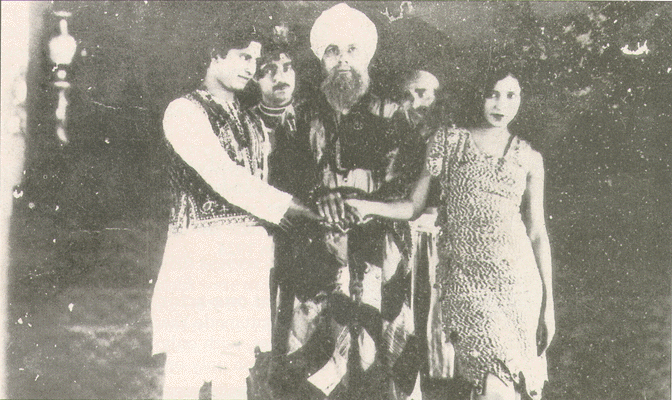
A scene from 'Alam Ara',
India's first talkie film.
|
THE
EARLY TALKIE
Himanshu Rai's 'A Throw of a Dice' ( starring himself opposite Seeta Devi) is listed as a
1930 'silent film'. But then it was also shown as an 'experimental sound film' in London
at a private screening. It had no dialogue, only 'sound effects', recorded and heard.
Technically therefore 'A Throw of a Dice' must rank as a 'silent film'.
To the surpassingly beauteous Sulochana (Ruby Meyers)must go the credit for the
Anglo-Indianisation of the swadeshi screen. Her film 'Madhuri' mounted the screen in 1928
as a 'silent film'. But it had such a striking dance sequence featuring Sulochana that an
attempt was made in 1930 to turn this part of the film into 'sound' by synchronising the
music to go with it.
The advent of the talkie was thus through a short film, represented by this dance sequence
of Sulochana. It was in keeping with the nationalistic spirit of the times that this clip
from her film 'Madhuri' was shown in September 1930, as a 'talkie short'alongside a
synchronised 'sound picture' of a Khadi exhibition. There is no record of whether the
Anglo-Indian Sulochana did that sequence attired in Khadi!
1931
So over to the year in which Indian motion picture began to talk.
As the maiden Indian Talkie, 'Alam Ara' was 10,000 feet long and it cost Rs.40,000/- to
put on screen. It had heroine Zubeida opposite the highest paid actor of the time : Stunt
King Master Vitthal. But the film itself, the story of a sultan with two wives, has no
action! 'Alam Ara' came at a time when its predecessor, the silent film, was at the zenith
of its popularity. So 'Alam Ara' was not rated as a substitute of the silent film.
'Alam Ara' was just the first among 24 Hindustani 'talkie'films to mount the silver screen
in 1931 as against 207 silent movies released that year.
'Alam Ara' brought the sound of music to the screen as Wazir Mohammed Khan becomes an
March 14 1931, India's first exponent of the film song with 'De de Khuda ke naam pe pyare
taaqat ho gar dene ki/Kuchch chahe agar to maang le mujse himmat ho gar lene ki'.
Sadly though, the full wording of this path breaking song is lost but Zubeida,the leading
lady of the movie bought it to life in a show called 'Mortal men Immortal
Melodies'transcreated in 1981 by Siddharth Kak.
Kajjan and Master Nissar became the sweethearts of the nation as Madan Theatres' 'Laila
Majnu' and 'Shirin Farhad' (starring the pair as legendary lovers) become the first two
talkie films to prove phenomenally popular. It is interesting to note that there was more
than one 'Laila Majnu', more than one 'Shakuntala', made during this inaugural talkie year
(1931) under different banners.
Also, to set off a 'Shirin Farhad' there is a 'Heer Ranjha'. Madan Theatres' came up with
a further interesting title in 'Third Wife', while a film named 'Devi Devyani' was an
early pointer to the two-in-one gossip legend who, some 35 years later, is to invade the
privacy of film stars with a vengeance!
|